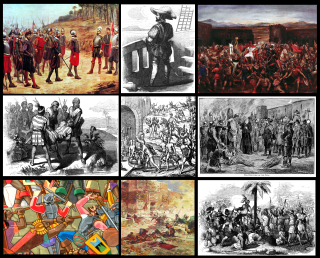 W
WThe Spanish conquest of the Inca Empire, also known as Conquest of Peru, was one of the most important campaigns in the Spanish colonization of the Americas. After years of preliminary exploration and military skirmishes, 168 Spanish soldiers under conquistador Francisco Pizarro, his brothers, and their native allies captured the Sapa Inca Atahualpa in the 1532 Battle of Cajamarca. It was the first step in a long campaign that took decades of fighting but ended in Spanish victory in 1572 and colonization of the region as the Viceroyalty of Peru. The conquest of the Inca Empire, led to spin-off campaigns into present-day Chile and Colombia, as well as expeditions towards the Amazon Basin.
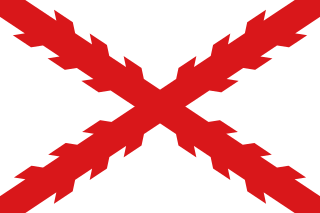 W
WThe Viceroyalty of Peru was a Spanish imperial provincial administrative district, created in 1542, that originally contained modern-day Peru and most of Spanish Empire South America, governed from the capital of Lima. Peru was one of the two Spanish Viceroyalties in the Americas from the sixteenth to the eighteenth centuries.
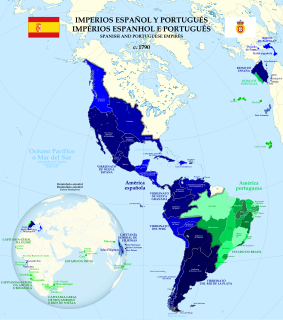 W
WThe Spanish colonization of the Americas began under the Crown of Castile and spearheaded by the Spanish conquistadors. The Americas were invaded and incorporated into the Spanish Empire, with the exception of Brazil, British America, and some small regions in South America and the Caribbean. The crown created civil and religious structures to administer this vast territory. The main motivations for colonial expansion were profit and the spread of Catholicism through indigenous conversions.
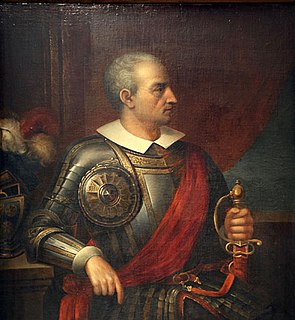 W
WDiego de Almagro, also known as El Adelantado and El Viejo, was a Spanish conquistador known for his exploits in western South America. He participated with Francisco Pizarro in the Spanish conquest of Peru. While subduing the Inca Empire he laid the foundation for Quito and Trujillo as Spanish cities in present-day Ecuador and Peru respectively. From Peru Almagro led the first Spanish military expedition to central Chile. Back in Peru, a longstanding conflict with Pizarro over the control of the former Inca capital of Cuzco erupted into a civil war between the two bands of conquistadores. In the battle of Las Salinas in 1538 Almagro was defeated by the Pizarro brothers and months later he was executed.
 W
WAlonso de Alvarado Montaya González de Cevallos y Miranda (1508–1555) was a Spanish conquistador and knight of the Order of Santiago.
 W
WManuel de Amat y Junyent, OSJ, OM was a Spanish military officer and colonial administrator. He was the Royal Governor of the Captaincy General of Chile from December 28, 1755 to September 9, 1761, and Viceroy of Peru from October 12, 1761 to July 17, 1776.
 W
WJuan Santos Atahualpa Apu-Inca Huayna Capac was the messianic leader of a successful indigenous rebellion in the Amazon Basin and Andean foothills against the Viceroyalty of Peru. The rebellion began in 1742 in the Gran Pajonal among the Asháninka people. Spanish Peru. The indigenous people expelled Roman Catholic missionaries and destroyed or forced the evacuation of 23 missions, many of them defended, in the central jungle area of Peru. Several Spanish military expeditions tried to suppress the rebellion but failed or were defeated. In 1752, Santos attempted to expand his rebellion into the Andes and gain the support of the highland people. He captured the town of Andamarca and held it for three days before withdrawing to the jungle. Santos disappeared from the historical record after 1752.
 W
WThe balconies of Cusco are colonial balconies found in much of the city of Cusco, Cusco Region, Peru. These wooden balconies are dated mostly to the Spanish colonial era and some to the early-Republican time.
 W
WThe balconies of Lima are items of cultural heritage built during the Viceroyalty of Peru and the Republic of Peru. Most of these balconies are of the Viceroyalty period, built in the late 17th and 18th centuries, are located in the Historic Center of Lima. They were adapted for residential purposes and have influenced the lives of many Peruvian scholars such as the 19th century writer Ricardo Palma.
 W
WPedro Peralta y Barnuevo was an Enlightenment-era Peruvian mathematician, cosmographer, historian, scholar, poet, and astronomer, and was considered a polymath. He was rector of University of San Marcos in Lima.
 W
WSebastián de Belalcázar was a Spanish conquistador. De Belalcázar, also written as de Benalcázar, is known as the founder of important early colonial cities in the northwestern part of South America; Quito in 1534 and Cali, Pasto and Popayán in 1537. De Belalcázar led expeditions in present-day Ecuador and Colombia and died of natural causes after being sentenced to death in Cartagena, at the Caribbean coast in 1551.
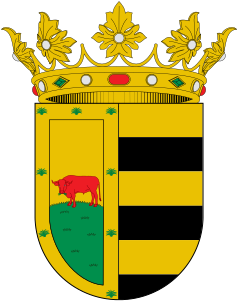 W
WAna Francisca Hermenegilda de Borja y Doria, condesa de Lemos (1640–1706) was the wife of Peruvian Viceroy Pedro Antonio Fernández de Castro, conde de Lemos. During his five-month absence from the capital, she was governor of the Viceroyalty. She thus became the first female governor of the Viceroyalty of Peru.
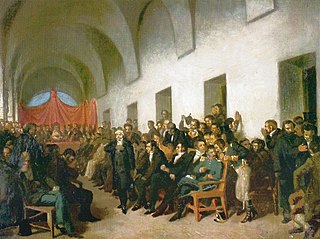 W
WA cabildo or ayuntamiento was a Spanish colonial, and early post-colonial, administrative council which governed a municipality. Cabildos were sometimes appointed, sometimes elected; but they were considered to be representative of all land-owning heads of household (vecinos). The colonial cabildo was essentially the same as the one developed in medieval Castile.
 W
WFrancisco de Carvajal was a Spanish military officer, conquistador, and explorer remembered as "the demon of the Andes" due to his brutality and uncanny military skill in the Peruvian civil wars of the 16th century.
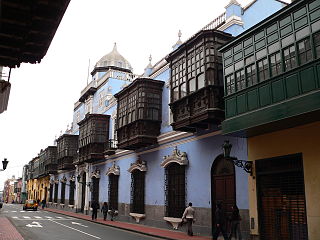 W
WOsambela House is one of the biggest houses built in Lima during the colonial Viceroyalty of Peru period. It is located at Conde de Superunda Street 298, in the historic centre of Lima. It is also called Casa de Oquendo.
 W
WCasta is a term which means "lineage" in Spanish and has been interpreted by certain historians during the 20th century to describe mixed-race individuals in Spanish America, resulting from unions of Spaniards, Amerindians, and Africans. Basic mixed-race categories that appeared in official colonial documentation were mestizo, generally offspring of a Spaniard and an indigenous person; mulato, offspring of a Spaniard and a black African. There were a plethora of terms for mixed-race persons of indigenous and African ancestry used in 18th century casta paintings yet never being used officially in the Spanish Empire.
 W
WThe Basilica Cathedral of Lima, otherwise Lima Cathedral, is a Roman Catholic cathedral located in the Plaza Mayor of downtown Lima, Peru. Construction began in 1535 and completed in 1649. It is dedicated to St John, Apostle and Evangelist.
 W
WThe Comentarios Reales de los Incas is a book written by Inca Garcilaso de la Vega, the first published mestizo writer of colonial Andean South America. The Comentarios Reales de los Incas is considered by most to be the unquestioned masterpiece of Inca Garcilaso de la Vega, born of the first generation after the Spanish conquest.
 W
WFrancisco Hernández Girón, born in Cáceres, Extremadura, died in Lima on December 7, 1554, was a Spanish conquistador.
 W
WLocated principally in the city centre or Cercado de Lima and Rímac areas, the Historic Centre of Lima is among the most important tourist destinations in Peru.
 W
WThe Historic Centre of Trujillo is the main urban area and the most important center of development and unfolding in the Peruvian city of Trujillo located in La Libertad Region. The whole process of its original urban fabric is in elliptical shape surrounded by España Avenue that was built in the wake of the Wall of Trujillo. It houses the seat of city government and other important entities in the locality. In the center of this historic urban area is the Plaza de Armas of Trujillo that was the scene of the Spanish founded of the city in 1534 and the proclamation of the independence of Trujillo on December 29, 1820.
 W
WThe Huancas, Wancas, or Wankas are a Quechua people living in the Junín Region of central Peru, in and around the Mantaro Valley.
 W
WA kuraka or curaca was an official of the Inca Empire who held the role of magistrate, about four levels down from the Sapa Inca, the head of the Empire. The kurakas were the heads of the ayllus. They served as tax collector, and held religious authority, in that they mediated between the supernatural sphere and the mortal realm. They were responsible for making sure the spirit world blessed the mortal one with prosperity, and were held accountable should disaster strike, such as a drought.
 W
WLobo, is a racial category in the Spanish colonial racial label for a mixed-race casta, far down the racial hierarchy created by the Spanish colonial regime privileging European whites.
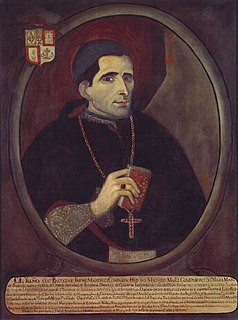 W
WBaltasar Jaime Martínez Compañón was a Spanish prelate who served as Bishop of Trujillo, Peru, Peru from 1779 to 1790, at Trujillo Cathedral, and Archbishop of Bogotá, New Granada, from 1790 to 1797. He was responsible for founding new towns, building schools, and reforming the silver mine at Hualgayoc. He is most remarkable for his efforts to educate Trujillo's Indians and for his research into local plants, animals, archaeological ruins, music, and native cultures.
 W
WAntonio de Mendoza y Pacheco was the first Viceroy of New Spain, serving from November 14, 1535 to November 25, 1550, and the third Viceroy of Peru, from September 23, 1551, until his death on July 21, 1552.
 W
WAntonio de Morga Sánchez Garay was a Spanish soldier, lawyer and a high-ranking colonial official for 43 years, in the Philippines, New Spain and Peru, where he was president of the Real Audiencia for 20 years.
 W
WNew Andalusia Governorate was one of the colonial governorates of the Spanish Empire, located in southern South America.
 W
WThe Governorate of New Castile was the gubernatorial region administered to Francisco Pizarro in 1528 by King Charles I of Spain, of which he was appointed governor.
 W
WThe New Laws, also known as the New Laws of the Indies for the Good Treatment and Preservation of the Indians, were issued on November 20, 1542, by Charles V, Holy Roman Emperor and regard the Spanish colonization of the Americas. Following complaints and calls for reform from individuals such as the Dominican friar Bartolomé de Las Casas, these laws were intended to prevent the exploitation and mistreatment of the indigenous peoples of the Americas by the encomenderos, by strictly limiting their power and dominion over groups of natives. The text of the New Laws has been translated into English.
 W
WThe Spanish Imperial Governorate of New Toledo was formed from the previous southern half of the Inca Empire, stretching south into present day central Chile, and east into present day central Brazil.
 W
WThe Palacio de Torre Tagle is a Baroque palace located at Jr. Ucayali 363, in downtown Lima, Peru, a couple blocks east of the Plaza de Armas. The palace currently is home to the Peruvian Ministry of Foreign Affairs.
 W
WThe Peruvian colonial architecture, developed in the Viceroyalty of Peru between the 16th and 19th centuries, was characterized by the importation and adaptation of European architectural styles to the Peruvian reality, yielding an original architecture.
 W
WThe Peruvian War of Independence was composed of a series of military conflicts in Peru beginning with viceroy Abascal military reconquest in 1811 in the battle of Guaqui, continuing with the definitive defeat of the Spanish Army in 1824 in the battle of Ayacucho, and culminating in 1826 with the Siege of Callao. The wars of independence took place with the background of the 1780–1781 uprising by indigenous leader Túpac Amaru II and the earlier removal of Upper Peru and the Río de la Plata regions from the Viceroyalty of Peru. Because of this the viceroy often had the support of the "Lima Oligarchy", who saw their elite interests threatened by popular rebellion and were opposed to the new commercial class in Buenos Aires. During the first decade of the 1800s Peru had been a stronghold for royalists, who fought those in favor of independence in Peru, Bolivia, Quito and Chile. Among the most important events during the war was the proclamation of independence of Peru by José de San Martín on 28 July 1821.
 W
WGonzalo Pizarro y Alonso was a Spanish conquistador and younger paternal half-brother of Francisco Pizarro, the conqueror of the Inca Empire. Bastard son of Captain Gonzalo Pizarro y Rodríguez de Aguilar (senior) (1446–1522) who as colonel of infantry served in the Italian campaigns under Gonzalo Fernández de Córdoba, and in Navarre, with some distinction, and María Alonso, from Trujillo. He was the half brother of Francisco and Hernándo Pizarro and the full brother of Juan Pizarro.
 W
WFrancisco de Quiñónez ; Spanish soldier who was appointed as governor of Chile for thirteen months, between May 1599 and June 1600.
 W
WDiego Quispe Tito (1611–1681) was a Quechua painter from Peru. He is considered the leader of the Cuzco School of painting.
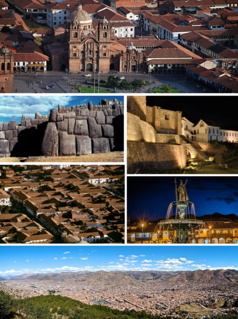 W
WCusco, often spelled Cuzco [ˈkusko], is a city in southeastern Peru near the Urubamba Valley of the Andes mountain range. It is the capital of the Cusco Region and of the Cusco Province. The city is the seventh most populous in Peru, and, in 2017, it had a population of 428,450. Its elevation is around 3,400 m (11,200 ft).
 W
WThe Rebellion of Túpac Amaru II was an uprising of native and mestizo peasants against the Bourbon reforms in the Spanish Viceroyalty of Peru. While Túpac Amaru II, an early leader of the rebellion, was captured and executed in 1781, the rebellion continued for at least another year under other leaders.
 W
WCusco, often spelled Cuzco [ˈkusko], is a city in southeastern Peru near the Urubamba Valley of the Andes mountain range. It is the capital of the Cusco Region and of the Cusco Province. The city is the seventh most populous in Peru, and, in 2017, it had a population of 428,450. Its elevation is around 3,400 m (11,200 ft).
 W
WThe Real Audiencia of Quito was an administrative unit in the Spanish Empire which had political, military, and religious jurisdiction over territories that today include Ecuador, parts of northern Peru, parts of southern Colombia and parts of northern Brazil. It was created by Royal Decree on 29 August 1563 by Philip II of Spain in the city of Guadalajara. It ended in 1822 with the incorporation of the area into the Republic of Gran Colombia.
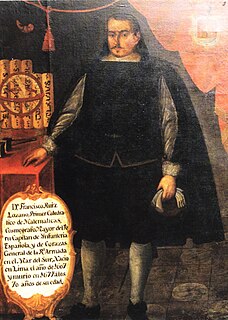 W
WFrancisco Ruiz Lozano was a Peruvian soldier, astronomer, mathematician and educator.
 W
WBasílica y Convento de San Francisco is the Spanish name for Saint Francis Monastery located in Lima, Peru, south of Parque la Muralla and one block northeast from the Plaza Mayor, Lima. The church and convent are part of the Historic Centre of Lima, which was added to the UNESCO World Heritage List in 1991. Aside from a church and monastery it also contains a library and catacombs. In this church, Jude the Apostle is venerated. At the feast of Saint Jude Tadeus a one and a half ton weighing silver stand is carried round in procession by 40 people, starting from the convent.
 W
WIglesia de San Pedro is the Spanish name for Saint Peter Church located in Lima, Peru. The church was completed in 1638.
 W
WSan Telmo was a Spanish 74-gun ship of the line, launched in 1788.
 W
WDon Juan Antonio de Tagle-Bracho y de la Pascua Calderón, Count of Casa Tagle de Trasierra was a Spanish/Peruvian aristocrat who alongside his uncle the Marquis of Torre Tagle, had high status in Spain and Peru in the 17th century.
 W
WJosé Gabriel Túpac Amaru — known as Túpac Amaru II — was the leader of a large Andean uprising against the Spanish in Peru, whose quelling resulted in his death. He later became a mythical figure in the Peruvian struggle for independence and indigenous rights movement, as well as an inspiration to myriad causes in Spanish America and beyond.
Toribio Alfonso de Mogrovejo was a Spanish prelate of the Catholic Church who served as the Archbishop of Lima from 1579 until his death. He first studied in the humanities and law before serving as a professor and later as the Grand Inquisitor at the behest of King Philip II. His piety and learning had reached the ears of the king who appointed him to that position which was considered unusual since he had no previous government or judicial experience. His noted work for the Inquisition earned him praise from the king who nominated him for the vacant Lima archdiocese. The pope confirmed this despite his protests.
 W
WThe Viceroyalty of New Granada was the name given on 27 May 1717, to the jurisdiction of the Spanish Empire in northern South America, corresponding to modern Colombia, Ecuador, and Venezuela. Created in 1717 by king Felipe V, inside of a new territorial control policy, it was suspended in 1723 due to financial problems and was restored in 1739 until the independence movement suspended it again in 1810. The territory corresponding to Panama was incorporated later in 1739, and the provinces of Venezuela were separated from the Viceroyalty and assigned to the Captaincy General of Venezuela in 1777. In addition to these core areas, the territory of the Viceroyalty of New Granada included Guyana, southwestern Suriname, parts of northwestern Brazil, and northern Peru.
 W
WThe Walls of Lima were a fortification consisting mainly of walls and bastions whose purpose was to defend the city of Lima from exterior attacks. It was built between 1684 and 1687, during the Viceroy Melchor de Navarra y Rocafull 's government.